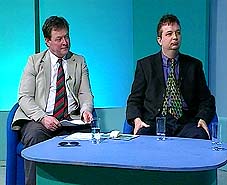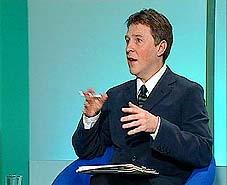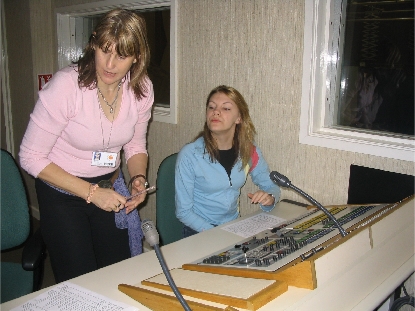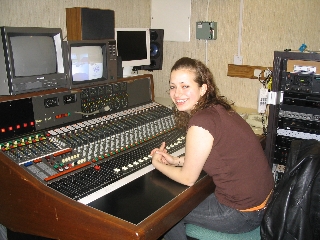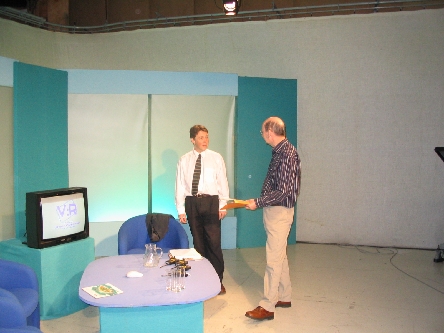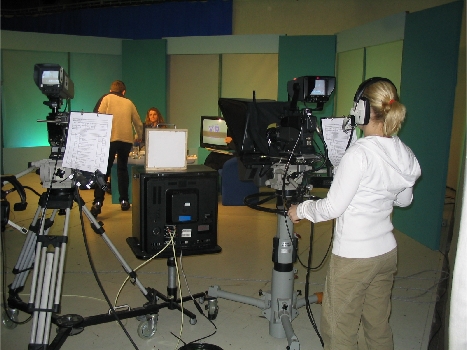 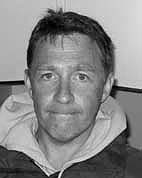 Mike O'Donoghue Lancaster University Back to Homepage
|
A new role for studio-based educational broadcasting. Mike
O'Donoghue |
|
Introduction The increase in the capacity of the Internet to transfer synchronous video in the late 1990s was a significant step in the development of webcasting and video streaming. Coupled with a general decrease in the price of digital video cameras and video production equipment the means to video broadcast to the world was suddenly available to many. The value of this resource to educational establishments reviewing their e-learning strategies was not lost. Until then the ability to produce video and to broadcast (on cable television or via satellite or other transmission signal) was firmly under the control of television studio personnel. Many universities in the UK had - and still have - their own television studio production unit, capable of producing professional quality broadcast material and in some cases offering live transmission. The technology for live webcasting and for producing recorded video for streaming has since progressed further, both in terms of the quality of recording and in terms of production and broadcast resource. Tutors and students alike now have the ability to produce their own video materials at a fraction of the cost of a studio and, though the quality might not be as good as that from a professional studio, many regard it as satisfactory and stream their video over the Internet live or soon after recoding and editing. As a consequence of this the question as to what is happening to the campus based television studio? What role does it play within a diversifying and expanding video production arena? Have television studio facilitie changed with the technology and adapted to meet new challenges made by educational technologists, perhaps retaining a role in the delivery of e-learning or other such strategy, or have they been side-lined or lost to other development? This short article seeks to investigate the contribution of studio-based television production for higher education within a rich ICT culture with a view to answering the question what is the future role for the campus-based television studio? Approach and production Video production and distribution in support of teaching and learning has many variations; the production of video resources for video streaming; live broadcast through the web or campus network; recorded lectures; video conferencing tutorials and how best to organise and support resources. At a meeting in Exeter, UK, Adrian Vranch and I discussed the possibilities of investigating the value of these resources in the delivery of materials to the DIVERSE community, to put into practice what we tended to preach on the value of video for educational use. This led us to the idea of producing a studio-based recording to promote the 5th DIVERSE conference in Nashville. In doing so our thoughts were to include the video resources at the essence of any DIVERSE conference discussion. Adrian and his colleagues operate the broadcast television studio at the University of Plymouth. As this studio was currently active with live educational broadcasting and production it made sense to use this studio as a production base for a short recording for the DIVERSE conference. In our planning the video promotion seemed particularly useful as a means of introducing Mark Childs, the chair of DIVERSE, to those planning to attend the conference - see him first, hear his ideas, and you'll have something to talk to him about when you meet him in Nashville. Alongside Mark the choice for our next studio guest had to be the conference organiser, Lori Schnieders, who could detail up-to-date conference information for potential conference delegates. Lori's involvement required a videoconference link in order to overcome the distance between the UK and the US. Further, this link allowed us to explore combined video applications- the use of a live videoconference within a live studio recording as a means to overcome issues of time and place. The format for this recording was likened to a news programme - perhaps Newsnight in the UK - where distant correspondents would report and interact with studio personnel within a live broadcast. There was little problem in gaining support from Mark and from Lori. Students were recruited into the studio from Lancaster and from Plymouth to assist in the technical aspects of the recording. Agreements on cost were made (more of which later) and a date for recording set. Producing an educational broadcast from a university television studio in a live format which required a live videoconference link between the UK and the US met many of the central themes of DIVERSE in one short production. Further, the possibility to explore a number of questions on the role of the television studio for educational purposes, not least to examine the role of the television studio - and all of the skills and practices this includes - alongside videoconference, video streaming and other video-related resources, provided the basis for an investigation from a series of perspectives. For me, going back to the same studio over a decade later offered a means to examine the nature of the developments that had taken place. Even at the earliest production stage, in discussing the details with colleagues at Plymouth, I began to observe changes to my current video production practice with videoconferencing (single and multipoint) and with video webcasting. Though I am a strong advocate for the educational benefits of each of these technologies, the awareness required on how each of these technologies operates towards a successful learning outcome in comparison to that required for the television studio seemed to be significantly less. The production detail and the focus on the content and message seemed to be significantly sharper for the studio. Even early production planning offered the sense of less margin for error in the studio in relation to the seemingly less formal videoconference or live webcast. Recording in the studio: as if I'd never left at all... Over ten years had passed since I last sat in the presenter's chair in the television studio at the University of Plymouth. In that time I've produced and presented work from other television studios in the UK, managed an educational cable television broadcast facility, and moved into webcasting when the technology was first ripe for experimentation. But it was in this studio at Plymouth that I cut my teeth in live educational broadcasting and production. Each week for three years the BBC trained Merryn Myatt guided me through aspects of studiocraft until I eventually took on the lead presenter/producer role. Entering this studio again was not dissimilar to going back to your old secondary school; you see yourself as you were then and at the same time as you are now. You get to see how far you've come and, in part, what you've learnt along the way. Twinning up again with David Hurrell was also exciting. Dave was one of the early studio directors I'd worked with and learnt from and this was useful in that Dave was aware of some of the demands I'd made of the studio in the early 1990's - asking for an online email connection and for a remote managed audio-bridge from the studio floor to enhance live broadcast interactivity, scary things for many directors to take on-board - so the format I had for this production, to include a live videoconference within a live transmission, was of little surprise to him. We worked on the dynamics of the sequences and discussed the problems we were likely to encounter and resolved as many as we could prior to recording. The videoconference with Lori Scheider had been scheduled the day before the studio recording was to take place. Lori's return audio and video from the videoconference was recorded with the audio component of the Plymouth participants onto high quality tape (Betacam). This decision was taken during production planning in order to reduce the risk of a breakdown with the videoconference link and due to the time difference between the US and the UK. In practice the videoconference took place in a separate building from the TV studio. The questions used for discussion had been agreed in advance with Lori. Of the three on-camera personnel only Adrian Vranch and I were present for the video conference. Mark Child's questions were asked by Adrian and I in his place; we anticipated Mark would ask his own questions in the studio the following day. In short, the videoconference of Lori seen in the video was pre-recorded and Mark, Adrian and I are interacting with a video playback during the live studio recording. It was agreed that the studio recording would be live-to-tape rather than live broadcast; in practice this means working your way through the broadcast running order as if the broadcast were a live transmission, except that the output is recorded to tape and not actually broadcast. With two rehearsals complete and dialogue sequences and timings practiced the live recording was made. Following inspection the recording was encoded for video streaming distribution. Production costs This short broadcast required production activity spread over a three week period. This involved discussion with the studio at Plymouth on possible uses of technology; studio layout; studio personnel organisation; presenter and guest negotiation; content and running order planning; video sequence preparation and editing; accommodation and transport planning; and financial discussion and negotiation. The total production cost have yet to be finalised, but including studio and staff costs, accommodation, and transport to Plymouth, the overall cost is expected to be around £2,500 (approx. US$4,500 / Euro3,700 / Can$5,600 / Aus$6,000). For a single production and recording this figure, though cheap in studio television production terms, is beyond the practical costs for many educational institutions. However, this cost was reduced as the same studio resources were used to produced a second live-to-tape recording for a separate educational project, so sharing the overall costs. This brings the production costs for the DIVERSE broadcast to less than half of the expected costs above. The costs were further reduced as three of the technical production team were students from Lancaster who had participated to gain experience, so were not directly paid. (These students participated in a new undergraduate module in Educational Studies at Lancaster on Educational Broadcasting, which is the topic of my presentation at DIVERSE 2005 in Nashville in July). A few of the outcomes Aside from production and cost examination this activity provided an opportunty to examine studio-based educational video and broadcast production and to examine the role of a television studio in the production and broadcast of educational materials. It is with this role in mind that the following points arise from this activity:
Summary In completing this production activity
and considering the themes for this brief article there
are a number of ideas to be further examined and issues
to explore. Whether this broadcast is effective, whether
it is value for money, whether other institutions would
be advised to copy this format in order to promote other
events - all of these points are debatable and readers
will form their own views. From the perspective of a
DIVERSE community - a community of practice centred on
the development of video and videoconferencing resources
for students/staff everywhere - the final question may be
whether we could not afford to attempt to put our ideas
into practice and so demonstrate them in this
recording Finally, if you were a senior manager
and you were wondering what to do with your current,
expensive, campus television studio, my advise would be
not to get rid of it, but to consider how it could
operate within the framework of institutional traditional
and e-learning production and distribution, to conisider
it as a resource which can operate alongside
videoconferencing and videostreaming facilities, and to
explore mechanisms to pass on the 'best practice' of
experienced educational video producers to other areas of
the institution.
|
|
|
This document was prepared for the DIVERSE newsletter May 2005 - ref: www.diverse-net.org/diversenl0505mod1.htm |
